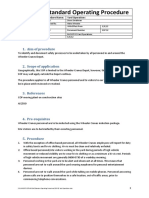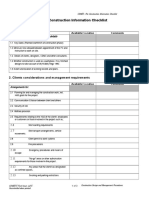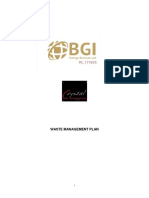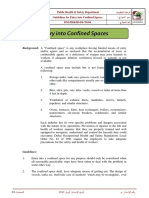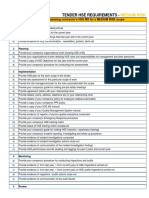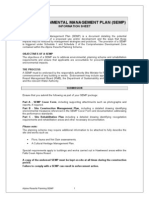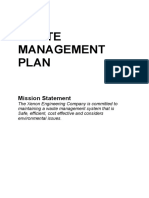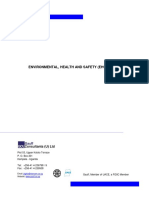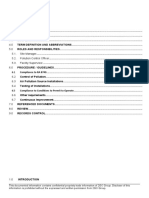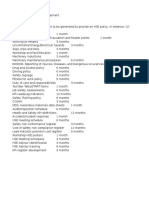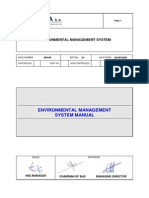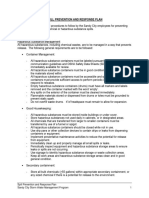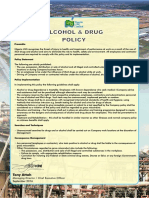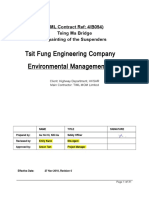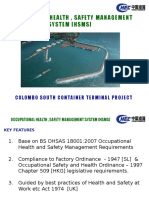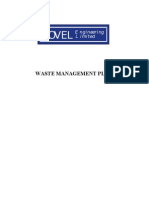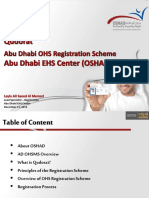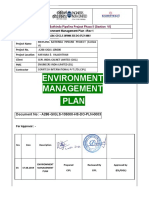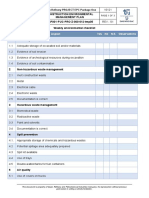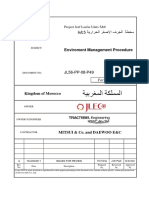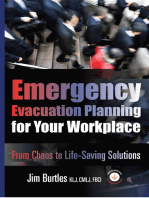Tool Box Talk Waste Segregation
Tool Box Talk Waste Segregation
Uploaded by
Ngel EvnsCopyright:
Available Formats
Tool Box Talk Waste Segregation
Tool Box Talk Waste Segregation
Uploaded by
Ngel EvnsOriginal Description:
Copyright
Available Formats
Share this document
Did you find this document useful?
Is this content inappropriate?
Copyright:
Available Formats
Tool Box Talk Waste Segregation
Tool Box Talk Waste Segregation
Uploaded by
Ngel EvnsCopyright:
Available Formats
TOOLBOX TALK
WASTE SEGREGATION
The segregation of waste produced into: hazardous, non-hazardous and inert waste types for disposal can help reduce costs and maximise the opportunities for recovery and recycling of the waste. When disposing of waste look out for the following standard signs on waste containers, which are being introduced across the UK to both encourage and improve the segregation of waste. By doing this we hope to be able to: Avoid prosecution: its illegal to mix hazardous waste with other types of waste that are to be sent directly to landfill. You could be fined up to 20,000 and imprisoned for up to 2 years. Avoid environmental harm: incorrectly disposing of hazardous waste could potentially create water pollution and damage habitats. Landfills and waste treatment centres are specially designed to be able to handle specific wastes without causing environmental harm. Reduce costs: segregating wastes can minimise landfill tax and can allow certain types of wastes to be recycled or reused on or off site.
DO: Look out for the standards and signs on skips and containers and where possible segregate waste . Use enclosed or covered skips for waste that is likely to blow around blow around site in windy conditions Ask your supervisor for advice if unsure about the correct waste segregation on site. DONT: X Overfill waste containers and skips. X Mix different types of waste. X Put liquids and flammable wastes into skips.
You might also like
- Environmental Management PlanDocument36 pagesEnvironmental Management Plankikiau92% (13)
- Nesic - Environmental Weekly Checklist: Inspection Conducted by Position Date of Inspection LocationDocument4 pagesNesic - Environmental Weekly Checklist: Inspection Conducted by Position Date of Inspection LocationMuhammad Waqas83% (6)
- SOP 02 Yard Operations PDFDocument4 pagesSOP 02 Yard Operations PDFakhmadbay0% (1)
- ESP Pre-Construction Information ChecklistDocument3 pagesESP Pre-Construction Information ChecklistNgel EvnsNo ratings yet
- 05-1-3.13 Waste Management PlanDocument6 pages05-1-3.13 Waste Management PlanOpuba Christian100% (1)
- Environmental Site Inspection ChecklistDocument6 pagesEnvironmental Site Inspection ChecklistAhmad Mensa100% (5)
- Health Safety Annual Report 13-14Document20 pagesHealth Safety Annual Report 13-14Myo Thant AungNo ratings yet
- DM-PH&SD-P4-TG04 - (Guidelines For Entry Into Confined Spaces)Document3 pagesDM-PH&SD-P4-TG04 - (Guidelines For Entry Into Confined Spaces)kevinNo ratings yet
- Waste Water Management PlanDocument41 pagesWaste Water Management PlanAsif100% (1)
- IoshDocument52 pagesIoshmohamed ghazyNo ratings yet
- Contents of Safety ProgramDocument2 pagesContents of Safety ProgramJohn Francis Sumandal100% (2)
- Hsems 8 ElementsDocument86 pagesHsems 8 ElementsIndermohan Mehta100% (2)
- Spill Procedure PDFDocument14 pagesSpill Procedure PDFNguyen Nghia100% (1)
- Tender HSE Requirements - DW1562Document2 pagesTender HSE Requirements - DW1562Chukwuma Emmanuel Onwufuju100% (1)
- Site Environmental Management Plan Information SheetDocument9 pagesSite Environmental Management Plan Information Sheetnanthad74No ratings yet
- HSSE Improvement PlanDocument2 pagesHSSE Improvement Plansubhadipmanna8No ratings yet
- Waste Management Plan: Mission StatementDocument6 pagesWaste Management Plan: Mission StatementxenonengineersNo ratings yet
- Confind SpaceDocument11 pagesConfind Spacesolomonbeg100% (1)
- IMS-CP-915 - Waste Reduction PlanDocument12 pagesIMS-CP-915 - Waste Reduction PlanKhalil A. AwanNo ratings yet
- Environmental Health and Safety Policy - Gcu 2017Document9 pagesEnvironmental Health and Safety Policy - Gcu 2017Michael KaziNo ratings yet
- Air and Noise Pollution Control ProcedureDocument6 pagesAir and Noise Pollution Control Procedure2GO Corporate HSENo ratings yet
- EMS 4.4.6 Waste Management Plan Rev-05Document12 pagesEMS 4.4.6 Waste Management Plan Rev-05elnaqa176100% (2)
- ED2 SampleDocument53 pagesED2 SampleadelNo ratings yet
- F013B Display Screen Equipment Self Assessment FormDocument3 pagesF013B Display Screen Equipment Self Assessment FormvladNo ratings yet
- Camden Gas Project - Environmental Health and Safety Management PlanDocument82 pagesCamden Gas Project - Environmental Health and Safety Management PlanHesham HassanNo ratings yet
- List of Legal Register and Other RequirementsDocument103 pagesList of Legal Register and Other RequirementsZubaidi OthmanNo ratings yet
- HSE MGT - System PDFDocument70 pagesHSE MGT - System PDFNaveen Chaudhary100% (2)
- HSEkpisDocument14 pagesHSEkpissam lissenNo ratings yet
- HSEMSDocument37 pagesHSEMSHafiz SabriNo ratings yet
- Environmental ManualDocument34 pagesEnvironmental Manualgs_humboldt100% (6)
- Buidling Safety Inspection ChecklistDocument4 pagesBuidling Safety Inspection ChecklistPillai Sreejith100% (17)
- Coshh Assessment FormDocument4 pagesCoshh Assessment FormLsri MurthyNo ratings yet
- Content:: Saudi Arabian Oil Company (Saudi Aramco) General Instruction ManualDocument8 pagesContent:: Saudi Arabian Oil Company (Saudi Aramco) General Instruction Manualhammadgull100% (1)
- HSE Integrated Management System - Internal Audit GuidanceDocument19 pagesHSE Integrated Management System - Internal Audit Guidancekrunalb@inNo ratings yet
- Environmental Impacts and Aspects Register EngDocument9 pagesEnvironmental Impacts and Aspects Register EngsjmpakNo ratings yet
- DEE EHU-03!5!1 Health and Safety Committee Meeting MinutesDocument2 pagesDEE EHU-03!5!1 Health and Safety Committee Meeting MinutesFred AlmaNo ratings yet
- Chemical Spill Procedure: 1. PurposeDocument2 pagesChemical Spill Procedure: 1. PurposeWalter A. Mustafa Takeo100% (1)
- Hazardous Waste DisposalDocument13 pagesHazardous Waste DisposalbooksbookNo ratings yet
- Spill Prevention and RespoDocument4 pagesSpill Prevention and RespoRenju AntonyNo ratings yet
- Procedure 07 - Environmental Aspect and Impact AssessmentDocument4 pagesProcedure 07 - Environmental Aspect and Impact Assessmentsuhara hussainNo ratings yet
- Appendix C - NLNG Alcohol & Drug PolicyDocument1 pageAppendix C - NLNG Alcohol & Drug PolicyAF Dowell MirinNo ratings yet
- Environmental Management Plan - rev 0 - 20181127 - 複製Document36 pagesEnvironmental Management Plan - rev 0 - 20181127 - 複製kikiau100% (2)
- Health and Safety Management SystemDocument24 pagesHealth and Safety Management SystemEmmanuel WinfulNo ratings yet
- NEBOSH Assignment Report Unit D 2017 PDFDocument80 pagesNEBOSH Assignment Report Unit D 2017 PDFSaeed MalikNo ratings yet
- NEBOSH Certificate in Environmental Management: What Kind of People Take The NEBOSHDocument2 pagesNEBOSH Certificate in Environmental Management: What Kind of People Take The NEBOSHNebosh IGC0% (1)
- EHS ManualDocument15 pagesEHS ManualM Zohaib Mudabber KhanNo ratings yet
- Job Safety Analysis: Gas Powered ChainsawDocument4 pagesJob Safety Analysis: Gas Powered ChainsawJuztin NovalNo ratings yet
- Waste Management PlanDocument14 pagesWaste Management PlanUwem Udofia100% (2)
- E PAKATSDocument1 pageE PAKATSAlvee AlzhariffNo ratings yet
- Layla - OshadDocument28 pagesLayla - OshadyasirNo ratings yet
- Barrick Contractor Safety PolicyDocument19 pagesBarrick Contractor Safety PolicysalorcNo ratings yet
- GoodHousekeepingPractices HazardousWasteManagementDocument4 pagesGoodHousekeepingPractices HazardousWasteManagementNuragus Hariyadi100% (1)
- Emergency Response and Spill ControlDocument5 pagesEmergency Response and Spill Controlbaluchakp100% (1)
- Environment Management Plan-MBPLDocument17 pagesEnvironment Management Plan-MBPLPNCPL PLANNING100% (1)
- Oil Spill Response Contingency Plan For Mumbai & JNPT HarbourDocument179 pagesOil Spill Response Contingency Plan For Mumbai & JNPT HarbourVaishnavi Jayakumar100% (1)
- Weekly Environmental ChecklistDocument3 pagesWeekly Environmental ChecklistibrahimNo ratings yet
- Environment ManagementDocument16 pagesEnvironment ManagementMohamed HadjkacemNo ratings yet
- Hazard Identification, Risk Assessment and Risk ControlDocument4 pagesHazard Identification, Risk Assessment and Risk ControlKumar GauravNo ratings yet
- Emergency Evacuation Planning for Your Workplace: From Chaos to Life-Saving SolutionsFrom EverandEmergency Evacuation Planning for Your Workplace: From Chaos to Life-Saving SolutionsNo ratings yet
- Confined Space - Permit To WorkDocument5 pagesConfined Space - Permit To WorkNgel EvnsNo ratings yet
- Parts of The BodyDocument1 pageParts of The BodyNgel EvnsNo ratings yet
- Photography NCFE Level 1 Certificate Project 1 - College LifeDocument6 pagesPhotography NCFE Level 1 Certificate Project 1 - College LifeNgel EvnsNo ratings yet


